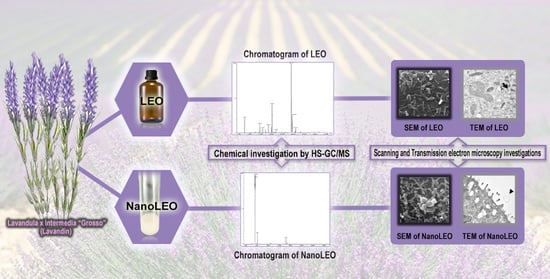Chemical Investigation and Screening of Anti-Proliferative Activity on Human Cell Lines of Pure and Nano-Formulated Lavandin Essential Oil
Abstract
1. Introduction
2. Results
2.1. LEO and NanoLEO Chemical Analysis
2.2. Nanoemulsion Characterization
2.3. Cytotoxicity Test (MTT)
2.4. Statistical Analysis
2.5. Ultrastructure Investigation by Electron Microscopy
3. Discussion
4. Materials and Methods
4.1. Materials
4.2. Gas Chromatography-Mass Spectrometry (GC-MS) Analysis
4.3. Head Space GC-MS Analysis
4.4. Nanoemulsion Preparation
4.5. Physicochemical Characterization of Nanoemulsions
4.6. MTT Test
4.7. Electron Microscopy
5. Conclusions
Supplementary Materials
Author Contributions
Funding
Acknowledgments
Conflicts of Interest
References
- Bernardini, S.; Tiezzi, A.; Laghezza Masci, V.; Ovidi, E. Natural products for human health: An historical overview of the drug discovery approaches. Nat. Prod. Res. 2017, 6419, 1–25. [Google Scholar] [CrossRef] [PubMed]
- El Asbahani, A.; Miladi, K.; Badri, W.; Sala, M.; Addi, E.H.A.; Casabianca, H.; El Mousadik, A.; Hartmann, D.; Jilale, A.; Renaud, F.N.R.; et al. Essential oils: From extraction to encapsulation. Int. J. Pharm. 2015, 483, 220–243. [Google Scholar] [CrossRef] [PubMed]
- Dhifi, W.; Bellili, S.; Jazi, S.; Bahloul, N.; Mnif, W. Essential Oils’ Chemical Characterization and Investigation of Some Biological Activities: A Critical Review. Medicines 2016, 3, 25. [Google Scholar] [CrossRef] [PubMed]
- Barra, A. Factors affecting chemical variability of essential oils: A review of recent developments. Nat. Prod. Commun. 2009, 4, 1147–1154. [Google Scholar] [CrossRef]
- Bakkali, F.; Averbeck, S.; Averbeck, D.; Idaomar, M. Biological effects of essential oils—A review. Food Chem. Toxicol. 2008, 46, 446–475. [Google Scholar] [CrossRef] [PubMed]
- Zuzarte, M.; Salgueiro, L. Essential oils chemistry. In Bioactive Essential Oils and Cancer; Springer: Cham, Switzerland, 2015; pp. 19–61. ISBN 9783319191447. [Google Scholar]
- Elshafie, H.S.; Camele, I. An overview of the biological effects of some mediterranean essential oils on human health. BioMed Res. Int. 2017. [Google Scholar] [CrossRef] [PubMed]
- Blowman, K.; Magalhães, M.; Lemos, M.F.L.; Cabral, C.; Pires, I.M. Anticancer Properties of Essential Oils and Other Natural Products. Evid.-Based Complement. Altern. Med. 2018, 2018, 1–12. [Google Scholar] [CrossRef]
- Aprotosoaie, A.C.; Gille, E.; Trifan, A.; Luca, V.S.; Miron, A. Essential oils of Lavandula genus: A systematic review of their chemistry. Phytochem. Rev. 2017, 16, 761–799. [Google Scholar] [CrossRef]
- Koziol, A.; Stryjewska, A.; Librowski, T.; Salat, K.; Gawel, M.; Moniczewski, A.; Lochynski, S. An Overview of the Pharmacological Properties and Potential Applications of Natural Monoterpenes. Mini-Rev. Med. Chem. 2014, 14, 1156–1168. [Google Scholar] [CrossRef]
- Cavanagh, H.M.A.; Wilkinson, J.M. Biological activities of lavender essential oil. Phytother. Res. 2002, 16, 301–308. [Google Scholar] [CrossRef]
- Kıvrak, Ş. Essential oil composition and antioxidant activities of eight cultivars of Lavender and Lavandin from western Anatolia. Ind. Crops Prod. 2018, 117, 88–96. [Google Scholar] [CrossRef]
- El Hassouni, A.; El Bachiri, A.; Belbachir, C.; Tahini, A. Chemical composition, antioxidant and antibacterial activity of essential oil of Lavandula dentata growing wild in Morocco. Am. J. Innov. Res. Appl. Sci. 2017, 4, 208–213. [Google Scholar]
- Djenane, D.; Aïder, M.; Yangüela, J.; Idir, L.; Gómez, D.; Roncalés, P. Antioxidant and antibacterial effects of Lavandula and Mentha essential oils in minced beef inoculated with E. coli O157:H7 and S. aureus during storage at abuse refrigeration temperature. Meat Sci. 2012, 92, 667–674. [Google Scholar] [CrossRef]
- Insawang, S.; Pripdeevech, P.; Tanapichatsakul, C.; Khruengsai, S.; Monggoot, S.; Nakham, T.; Artrod, A.; D’Souza, P.E.; Panuwet, P. Essential Oil Compositions and Antibacterial and Antioxidant Activities of Five Lavandula stoechas Cultivars Grown in Thailand. Chem. Biodivers. 2019, 16. [Google Scholar] [CrossRef] [PubMed]
- Chioca, L.R.; Ferro, M.M.; Baretta, I.P.; Oliveira, S.M.; Silva, C.R.; Ferreira, J.; Losso, E.M.; Andreatini, R. Anxiolytic-like effect of lavender essential oil inhalation in mice: Participation of serotonergic but not GABAA/benzodiazepine neurotransmission. J. Ethnopharmacol. 2013, 147, 412–418. [Google Scholar] [CrossRef] [PubMed]
- López, V.; Nielsen, B.; Solas, M.; Ramírez, M.J.; Jäger, A.K. Exploring pharmacological mechanisms of lavender (Lavandula angustifolia) essential oil on central nervous system targets. Front. Pharmacol. 2017, 8. [Google Scholar] [CrossRef] [PubMed]
- Zhang, N.; Yao, L. Anxiolytic Effect of Essential Oils and Their Constituents: A Review. J. Agric. Food Chem. 2019, 67, 13790–13808. [Google Scholar] [CrossRef]
- Garzoli, S.; Turchetti, G.; Giacomello, P.; Tiezzi, A.; Masci, V.L.; Ovidi, E. Liquid and vapour phase of lavandin (Lavandula × intermedia) Essential Oil: Chemical composition and antimicrobial activity. Molecules 2019, 24, 2701. [Google Scholar] [CrossRef]
- Prashar, A.; Locke, I.C.; Evans, C.S. Cytotoxicity of lavender oil and its major components to human skin cells. Cell Prolif. 2004, 37, 221–229. [Google Scholar] [CrossRef]
- Nikolić, M.; Jovanović, K.K.; Marković, T.; Marković, D.; Gligorijević, N.; Radulović, S.; Soković, M. Chemical composition, antimicrobial, and cytotoxic properties of five Lamiaceae essential oils. Ind. Crops Prod. 2014, 61, 225–232. [Google Scholar] [CrossRef]
- Cardia, G.F.E.; Silva-Filho, S.E.; Silva, E.L.; Uchida, N.S.; Cavalcante, H.A.O.; Cassarotti, L.L.; Salvadego, V.E.C.; Spironello, R.A.; Bersani-Amado, C.A.; Cuman, R.K.N. Effect of Lavender (Lavandula angustifolia) Essential Oil on Acute Inflammatory Response. Evid.-Based Complement. Altern. Med. 2018, 2018, 1–10. [Google Scholar] [CrossRef] [PubMed]
- da Silva, G.L.; Luft, C.; Lunardelli, A.; Amaral, R.H.; da Silva Melo, D.A.; Donadio, M.V.F.; Nunes, F.B.; de Azambuja, M.S.; Santana, J.C.; Moraes, C.M.B.; et al. Antioxidant, analgesic and anti-inflammatory effects of lavender essential oil. An. Acad. Bras. Cienc. 2015, 87, 1397–1408. [Google Scholar] [CrossRef] [PubMed]
- Fernandes, J. Bioactive Essential Oils and Cancer; de Sousa, D.P., Ed.; Springer: Cham, Switzerland, 2015; ISBN 978-3-319-19143-0. [Google Scholar]
- Tayarani-Najaran, Z.; Amiri, A.; Karimi, G.; Emami, S.A.; Asili, J.; Mousavi, S.H. Comparative studies of cytotoxic and apoptotic properties of different extracts and the essential oil of lavandula angustifolia on malignant and normal cells. Nutr. Cancer 2014, 66, 424–434. [Google Scholar] [CrossRef] [PubMed]
- Woronuk, G.; Demissie, Z.; Rheault, M.; Mahmoud, S. Biosynthesis and Therapeutic Properties of Lavandula Essential Oil Constituents. Planta Med. 2011, 77, 7–15. [Google Scholar] [CrossRef]
- Gezici, S. Original article Promising anticancer activity of lavender (Lavandula angustifolia Mill.) essential oil through induction of both apoptosis and necrosis. Ann. Phytomed. Int. J. 2019, 7, 38–45. [Google Scholar] [CrossRef]
- Masci, V.L.; Ovidi, E.; Taddei, A.R.; Turchetti, G.; Tiezzi, A.; Giacomello, P.; Garzoli, S. Apoptotic effects on HL60 human leukaemia cells induced by Lavandin essential oil treatment. Molecules 2020, 25, 538. [Google Scholar] [CrossRef]
- Sobral, M.V.; Xavier, A.L.; Lima, T.C.; Sousa, D.P. De Review Article Antitumor Activity of Monoterpenes Found in Essential Oils. Sci. World J. 2014. [Google Scholar] [CrossRef]
- Gu, Y.; Ting, Z.; Qiu, X.; Zhang, X.; Gan, X.; Fang, Y.; Xu, X.; Xu, R. Linalool preferentially induces robust apoptosis of a variety of leukemia cells via upregulating p53 and cyclin-dependent kinase inhibitors. Toxicology 2010, 268, 19–24. [Google Scholar] [CrossRef]
- Chang, M.Y.; Shieh, D.E.; Chen, C.C.; Yeh, C.S.; Dong, H.P. Linalool induces cell cycle arrest and apoptosis in leukemia cells and cervical cancer cells through CDKIs. Int. J. Mol. Sci. 2015, 16, 28169–28179. [Google Scholar] [CrossRef]
- Rodenak-Kladniew, B.; Castro, A.; Stärkel, P.; De Saeger, C.; de Bravo, M.G.; Crespo, R. Linalool induces cell cycle arrest and apoptosis in HepG2 cells through oxidative stress generation and modulation of Ras/MAPK and Akt/mTOR pathways. Life Sci. 2018, 199, 48–59. [Google Scholar] [CrossRef]
- Murata, S.; Shiragami, R.; Kosugi, C.; Tezuka, T.; Yamazaki, M.; Hirano, A.; Yoshimura, Y.; Suzuki, M.; Shuto, K.; Ohkohchi, N.; et al. Antitumor effect of 1, 8-cineole against colon cancer. Oncol. Rep. 2013, 30, 2647–2652. [Google Scholar] [CrossRef] [PubMed]
- Zhao, Y.; Chen, R.; Wang, Y.; Qing, C.; Wang, W.; Yang, Y. In Vitro and in Vivo Efficacy Studies of Lavender angustifolia Essential Oil and Its Active Constituents on the Proliferation of Human Prostate Cancer. Integr. Cancer Ther. 2017, 16, 215–226. [Google Scholar] [CrossRef]
- Baptista-Silva, S.; Borges, S.; Ramos, O.L.; Pintado, M.; Sarmento, B. The progress of essential oils as potential therapeutic agents: A review. J. Essent. Oil Res. 2020, 32, 279–295. [Google Scholar] [CrossRef]
- Pavoni, L.; Perinelli, D.R.; Bonacucina, G.; Cespi, M.; Palmieri, G.F. An Overview of Micro- and Nanoemulsions as Vehicles for Essential Oils: Formulation, Preparation and Stability. Nanomaterials 2020, 10, 135. [Google Scholar] [CrossRef]
- Garzoli, S.; Petralito, S.; Ovidi, E.; Turchetti, G.; Masci, V.L.; Tiezzi, A.; Trilli, J.; Cesa, S.; Casadei, M.A.; Giacomello, P.; et al. Lavandula x intermedia essential oil and hydrolate: Evaluation of chemical composition and antibacterial activity before and after formulation in nanoemulsion. Ind. Crops Prod. 2020, 145, 112068. [Google Scholar] [CrossRef]
- Gautam, N.; Mantha, A.K.; Mitta, S. Essential Oils and Their Constituents as Anticancer Agents: A Mechanistic View. BioMed Res. Int. 2014, 2014, 154106. [Google Scholar] [CrossRef] [PubMed]
- Russo, R.; Corasaniti, M.T.; Bagetta, G.; Morrone, L.A. Exploitation of Cytotoxicity of Some Essential Oils for Translation in Cancer Therapy. Evid.-Based Complement. Altern. Med. 2015, 2015, 397821. [Google Scholar] [CrossRef]
- de Queiroz, R.M.; Takiya, C.M.; Guimarães, L.P.T.P.; Rocha, G.G.; Alviano, D.S.; Blank, A.F.; Alviano, C.S.; Gattass, C.R. Apoptosis-Inducing Effects of Melissa officinalis L. Essential Oil in Glioblastoma Multiforme Cells. Cancer Investig. 2014, 32, 226–235. [Google Scholar] [CrossRef]
- Liu, J.; She, H.-M.; Choon-Nam, O. Salvia miltiorrhiza inhibits cell growth and induces apoptosis in human hepatoma HepG2 cells. Cancer Lett. 2000, 153, 85–93. [Google Scholar] [CrossRef]
- Li, Y.; Li, M.-Y.; Wang, L.; Jiang, Z.-H.; Li, W.-Y.; Li, H. Induction of apoptosis of cultured epatocarcinoma cell by essential oil of Artemisia annul L. Sichuan Da Xue Xue Bao Yi Xue Ban 2004, 35, 337–339. [Google Scholar]
- Buhagiar, J.A.; Podesta, M.T.C.; Wilson, A.P.; Micallef, M.J.; Ali, S. The induction of apoptosis in human melanoma, breast and ovarian cancer cell lines using an essential oil extract from the conifer Tetraclinis articulata. Anticancer Res. 1999, 19, 5435–5443. [Google Scholar] [PubMed]
- Tundis, R.; Loizzo, M.R.; Bonesi, M.; Menichin, F.; Dodaro, D.; Passalacqua, N.G.; Statti, G. In vitro cytotoxic effects of Senecio stabianus Lacaita (Asteraceae) on human cancer cell lines. Nat. Prod. Res. 2009, 23, 1707–1718. [Google Scholar] [CrossRef]
- Chiang, L.C.; Chiang, W.; Chang, M.Y.; Ng, L.T.; Lin, C.C. Antileukemic activity of selected natural products in Taiwan. Am. J. Chin. Med. 2003, 31, 37–46. [Google Scholar] [CrossRef] [PubMed]
- Itani, W.S.; El-Banna, S.H.; Hassan, S.B.; Larsson, R.L.; Bazarbachi, A.; Gali-Muhtasib, H.U. Anti-colon cancer components from Lebanese sage (Salvia libanotica) essential oil: Mechanistic basis. Cancer Biol. Ther. 2008, 7, 1765–1773. [Google Scholar] [CrossRef] [PubMed]
- Hayes, A.J.; Leach, D.N.; Markham, J.L.; Markovic, B. In vitro cytotoxicity of Australian tea tree oil using human cell lines. J. Essent. Oil Res. 1997, 9, 575–582. [Google Scholar] [CrossRef]
- Cha, J.; Kim, Y.; Kim, J. Essential oil and 1,8-cineole from Artemisia lavandulaefolia induces apoptosis in KB cells via mitochondrial stress and caspase activation. Food Sci. Biotechnol. 2010, 19, 185–191. [Google Scholar] [CrossRef]
- Tabatabaei, S.M.; Kianinodeh, F.; Nasiri, M.; Tightiz, N.; Asadipour, M.; Gohari, M. In Vitro Inhibition of MCF-7 Human Breast Cancer Cells by Essential Oils of Rosmarinus officinalis, Thymus vulgaris L., and Lavender x intermedia. Arch. Breast Cancer 2018, 5, 81–89. [Google Scholar]
- Sánchez-López, E.; Guerra, M.; Dias-Ferreira, J.; Lopez-Machado, A.; Ettcheto, M.; Cano, A.; Espina, M.; Camins, A.; Garcia, M.L.; Souto, E.B. Current Applications of Nanoemulsions in Cancer Therapeutics. Nanomaterials 2019, 9, 821. [Google Scholar] [CrossRef]
- Periasamy, S.V.; Atthinarayanan, J.; Alshatwi, A.A. Anticancer activity of an ultrasonic nanoemulsion formulation of Nigella sativa L. essential oil on human breast cancer cells. Ultrason. Sonochem. 2016, 31, 449–455. [Google Scholar] [CrossRef]
- Salehi, F.; Behboudi, H.; Kavoosi, G.; Ardestani, S.K. Incorporation of Zataria multiflora essential oil into chitosan biopolymer nanoparticles: A nanoemulsion based delivery system to improve the in-vitro efficacy, stability and anticancer activity of ZEO against breast cancer cells. Int. J. Biol. Macromol. 2020, 143, 382–392. [Google Scholar] [CrossRef]
- Al-Otaibi, W.; Alkhatib, M.H.; Noor Wali, A. Cytotoxicity and apoptosis enhancement in breast and cervical cancer cells upon coadministration of mitomycin C and essential oils in nanoemulsio formulations. Biomed. Pharmacother. 2017, 106, 946–955. [Google Scholar] [CrossRef]
- Liu, S.; Chen, D.; Yuan, Y.; Zhang, X.; Li, Y.; Yan, S.; Zhang, J. Efficient intracellular delivery makes cancer cells sensitive to nanoemulsive chemodrugs. Oncotarget 2017, 8, 65042–65055. [Google Scholar] [CrossRef] [PubMed]
- Donadu, M.G.; Usai, D.; Mazzarello, V.; Molicotti, P.; Cannas, S.; Bellardi, M.G.; Zanetti, S. Change in Caco-2 cells following treatment with various lavender essential oils. Nat. Prod. Res. 2017, 31, 2203–2206. [Google Scholar] [CrossRef]
- Conner, S.D.; Schmid, S.L. Regulated portals of entry into the cell. Nature 2003, 422, 37–44. [Google Scholar] [CrossRef]
- Chithrani, B.D.; Chan, W.C.W. Elucidating the Mechanism of Cellular Uptake and Removal of Protein-Coated Gold Nanoparticles of Different Sizes and Shapes. Nano Lett. 2007, 7, 1542–1550. [Google Scholar] [CrossRef] [PubMed]
- Jiang, W.; KimBetty, Y.S.; Rutka, J.T.; ChanWarren, C.W. Nanoparticle-mediated cellular response is size-dependent. Nat. Nano. 2008, 3, 145–150. [Google Scholar] [CrossRef] [PubMed]
- Yao, M.; He, L.; McClements, D.J.; Xiao, H. Uptake of Gold Nanoparticles by Intestinal Epithelial Cells: Impact of Particle Size on Their Absorption, Accumulation, and Toxicity. J. Agric. Food Chem. 2015, 63, 8044–8049. [Google Scholar] [CrossRef]
- Petit, P.X.; Zamzami, N.; Vayssière, J.-L.; Mignotte, B.; Kroemer, G.; Castedo, M. Implication of mitochondria in apoptosis. Mol. Cell. Biochem. 1997, 174, 185–188. [Google Scholar] [CrossRef]
- Ulivieri, C. Cell death: Insights into the ultrastructure of mitochondria. Tissue Cell. 2010, 2, 339–347. [Google Scholar] [CrossRef]
- Sanchez-Alcazar, J.A.; Rodriguez-Hernandez, A.; Cordero, M.D.; Fernandez-Ayala, D.J.; Brea-Calvo, G.; Garcia, K.; Navas, P. Theapoptotic microtubule network preserves plasma membrane integ-rity during the execution phase of apoptosis. Apoptosis 2007, 12, 1195–1208. [Google Scholar] [CrossRef]
- Moss, D.K.; Lane, J.D. Microtubules: Forgotten players in theapoptotic execution phase. Trends Cell Biol. 2006, 16, 330–338. [Google Scholar] [CrossRef]
- Karnovsky, M.J. A formaldehyde-glutaraldehyde fixative of high osmolality for use in electron microscopy. J. Cell Biol. 1965, 27, 137–138. [Google Scholar]
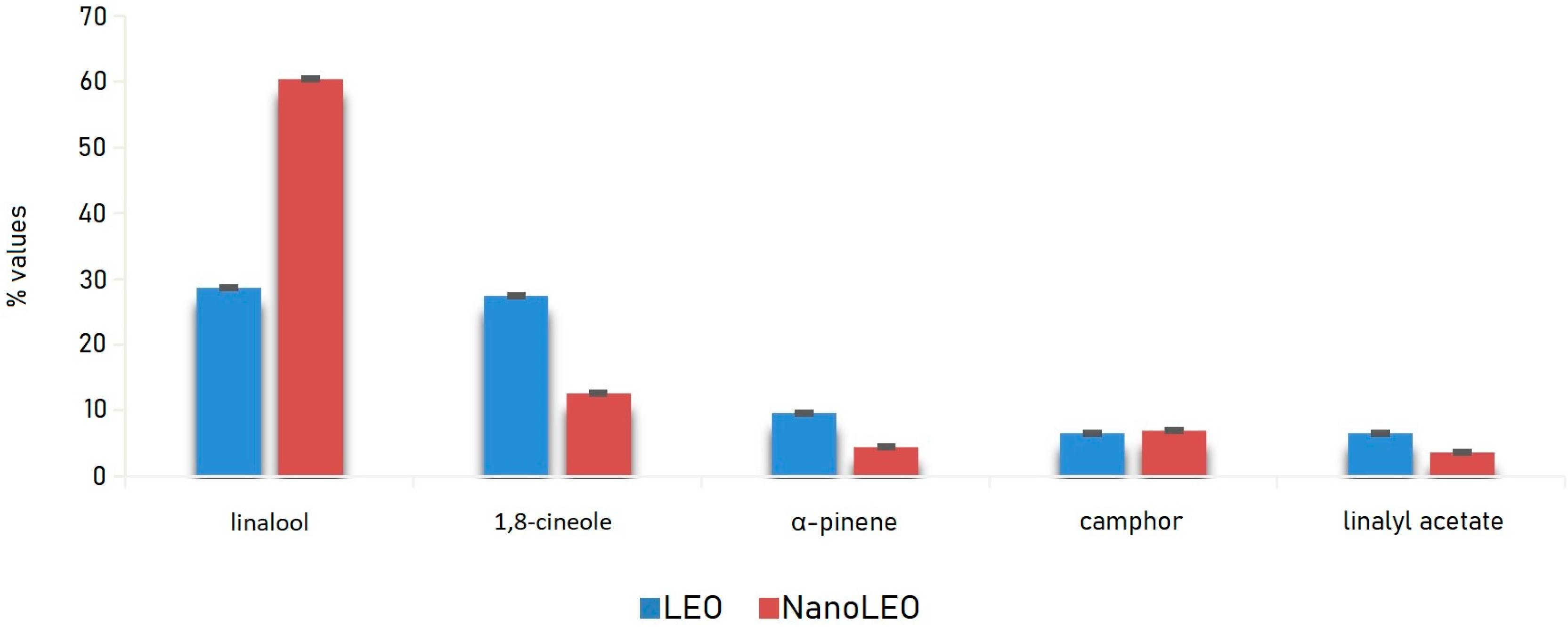
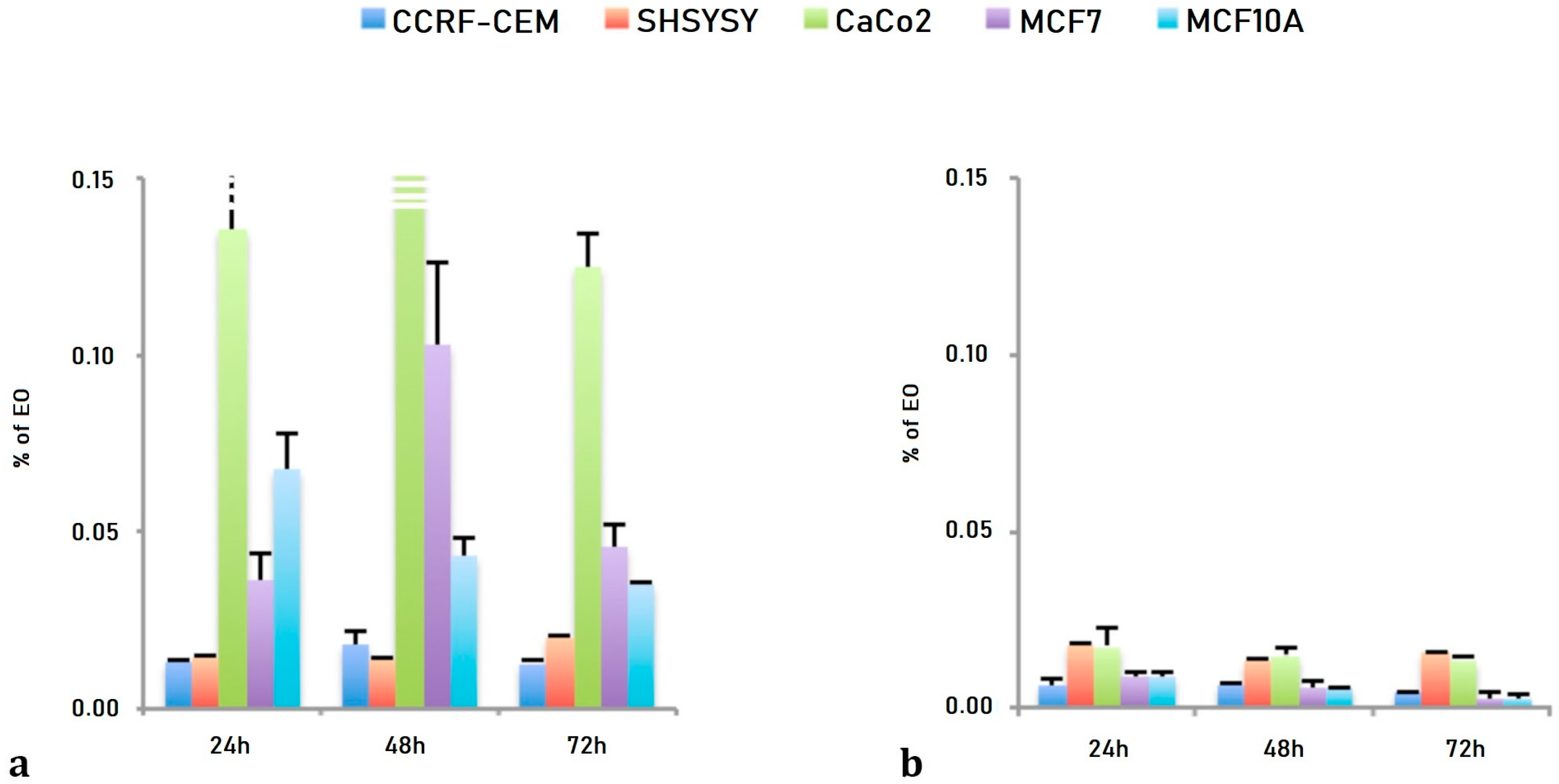
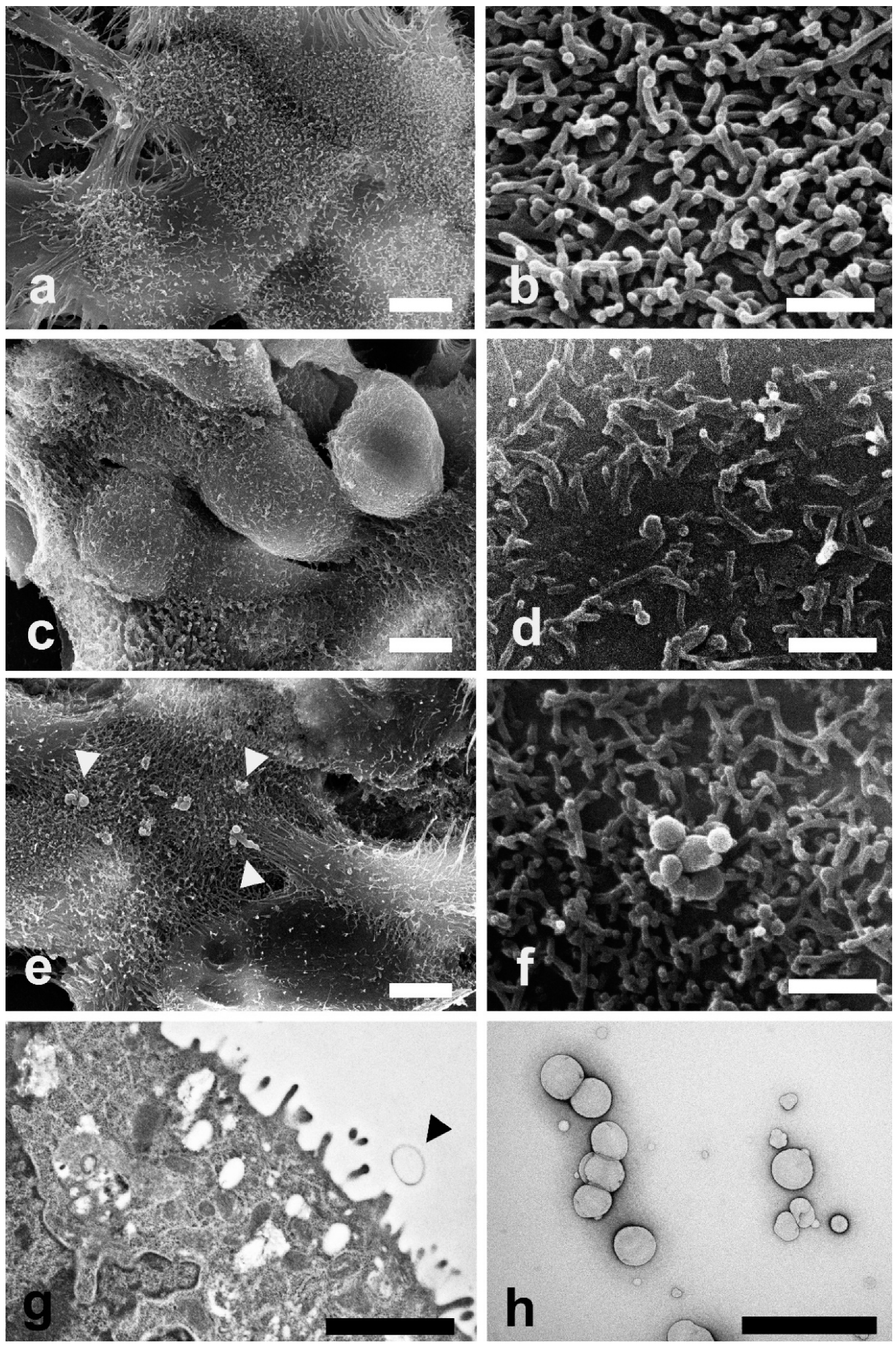
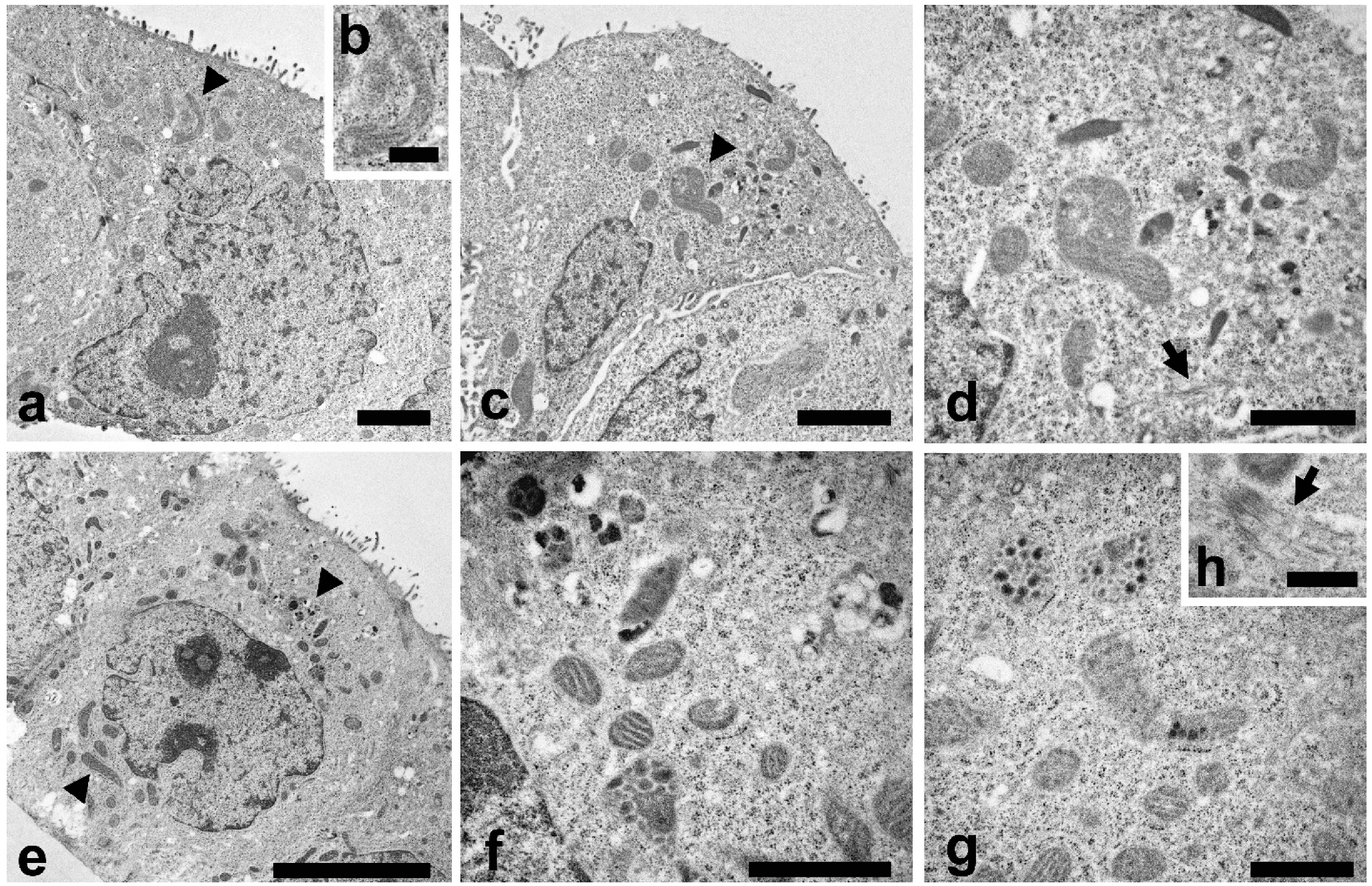
| N° | Component 1 | LRIlit 2 | LRI 3 | LEO Area (%) | NanoLEO Area (%) |
|---|---|---|---|---|---|
| 1 | α-pinene | 1021 | 1018 | 9.6 ± 0.01 | 4.5 ± 0.02 |
| 2 | camphene | 1065 | 1058 | 4.4 ± 0.01 | - |
| 3 | β-pinene | 1105 | 1101 | 3.3 ± 0.15 | - |
| 4 | limonene | 1198 | 1192 | 3.6 ± 0.02 | 0.6 ± 0.02 |
| 5 | 1,8-cineole | 1209 | 1201 | 27.4 ± 0.01 | 12.6 ± 0.01 |
| 6 | (Z)-β-ocimene | 1237 | 1232 | 0.5 ± 0.04 | 1.4 ± 0.01 |
| 7 | acetic acid hexyl ester | 1275 | 1271 | - | 0.5 ± 0.03 |
| 8 | trans-β-ocimene | 1276 | 1274 | 0.4 ± 0.02 | - |
| 9 | terpinolene | 1282 | 1281 | - | 0.4 ± 0.01 |
| 10 | o-cymene | 1287 | 1291 | 1.7 ± 0.01 | - |
| 11 | propanoic acid, 2-methyl-hexyl ester | 1335 | 1330 | 0.3 ± 0.01 | 0.5 ± 0.02 |
| 12 | 1-octen-3-yl-acetate | 1401.9 | 1401 | 0.6 ± 0.02 | 0.8 ± 0.01 |
| 13 | hexyl butanoate | 1410 | 1412 | 0.6 ± 0.04 | - |
| 14 | linalool oxide | 1423 | 1426 | 1.6 ± 0.02 | 1.4 ± 0.01 |
| 15 | 1-octen-3-ol | 1458 | 1462 | 0.7 ± 0.01 | 0.3 ± 0.01 |
| 16 | camphor | 1507 | 1501 | 6.5 ± 0.02 | 7.0 ± 0.01 |
| 17 | linalool | 1537 | 1538 | 28.6 ± 0.04 | 60.4 ± 0.03 |
| 18 | linalyl acetate | 1553 | 1550 | 6.5 ± 0.01 | 3.6 ± 0.01 |
| 19 | lavandulyl acetate | 1584 | 1579 | 0.8 ± 0.01 | - |
| 20 | terpinen-4-ol | 1603 | 1601 | 1.5 ± 0.02 | 2.9 ± 0.02 |
| 21 | lavandulol | 1662 | 1665 | 0.3 ± 0.02 | 0.3 ± 0.01 |
| 22 | α-terpineol | 1675 | 1678 | 0.3 ± 0.02 | 1.3 ± 0.02 |
| 23 | borneol | 1717 | 1720 | 0.8 ± 0.02 | 1.5 ± 0.01 |
| Total (%) | 100.0 | 100.0 |
| Cell Line | Time | EC50 % of EO (Mean ± SD) | |
|---|---|---|---|
| LEO | NanoLEO | ||
| CCRF-CEM | 24 h | 1.30 × 10−2 ± 0.09 × 10−2 | 0.57 × 10−2 ± 0.08 × 10−2 |
| 48 h | 1.80 × 10−2 ± 0.37 × 10−2 | 0.47 × 10−2 ± 0.08 × 10−2 | |
| 72 h | 1.25 × 10−2 ± 0.08 × 10−2 | 0.87 × 10−2 ± 0.05 × 10−2 | |
| SHSY5Y | 24 h | 1.42 × 10−2 ± 0.08 × 10−2 | 0.64 × 10−2 ± 0.05 × 10−2 |
| 48 h | 1.35 × 10−2 ± 0.08 × 10−2 | 0.62 × 10−2 ± 0.05 × 10−2 | |
| 72 h | 1.97 × 10−2 ± 0.10 × 10−2 | 0.44 × 10−2 ± 0.02 × 10−2 | |
| Caco2 | 24 h | 13.52 × 10−2 ± 1.97 × 10−2 | 1.79 × 10−2 ± 0.53 × 10−2 |
| 48 h | 24.12 × 10−2 ± 0.60 × 10−2 | 1.33 × 10−2 ± 0.28 × 10−2 | |
| 72 h | 12.45 × 10−2 ± 0.99 × 10−2 | 1.58 × 10−2 ± 0.09 × 10−2 | |
| MCF-7 | 24 h | 3.62 × 10−2 ± 0.76 × 10−2 | 1.73 × 10−2 ± 0.10 × 10−2 |
| 48 h | 10.25 × 10−2 ± 2.33 × 10−2 | 1.47 × 10−2 ± 0.20 × 10−2 | |
| 72 h | 4.53 × 10−2 ± 0.68 × 10−2 | 1.35 × 10−2 ± 0.21 × 10−2 | |
| MCF-10A | 24 h | 6.73 × 10−2 ± 1.04 × 10−2 | 0.90 × 10−2 ± 0.14 × 10−2 |
| 48 h | 4.28 × 10−2 ± 0.51 × 10−2 | 0.60 × 10−2 ± 0.02 × 10−2 | |
| 72 h | 3.47 × 10−2 ± 0.06 × 10−2 | 0.25 × 10−2 ± 0.14 × 10−2 | |
Publisher’s Note: MDPI stays neutral with regard to jurisdictional claims in published maps and institutional affiliations. |
© 2020 by the authors. Licensee MDPI, Basel, Switzerland. This article is an open access article distributed under the terms and conditions of the Creative Commons Attribution (CC BY) license (http://creativecommons.org/licenses/by/4.0/).
Share and Cite
Ovidi, E.; Masci, V.L.; Taddei, A.R.; Paolicelli, P.; Petralito, S.; Trilli, J.; Mastrogiovanni, F.; Tiezzi, A.; Casadei, M.A.; Giacomello, P.; et al. Chemical Investigation and Screening of Anti-Proliferative Activity on Human Cell Lines of Pure and Nano-Formulated Lavandin Essential Oil. Pharmaceuticals 2020, 13, 352. https://doi.org/10.3390/ph13110352
Ovidi E, Masci VL, Taddei AR, Paolicelli P, Petralito S, Trilli J, Mastrogiovanni F, Tiezzi A, Casadei MA, Giacomello P, et al. Chemical Investigation and Screening of Anti-Proliferative Activity on Human Cell Lines of Pure and Nano-Formulated Lavandin Essential Oil. Pharmaceuticals. 2020; 13(11):352. https://doi.org/10.3390/ph13110352
Chicago/Turabian StyleOvidi, Elisa, Valentina Laghezza Masci, Anna Rita Taddei, Patrizia Paolicelli, Stefania Petralito, Jordan Trilli, Fabio Mastrogiovanni, Antonio Tiezzi, Maria Antonietta Casadei, Pierluigi Giacomello, and et al. 2020. "Chemical Investigation and Screening of Anti-Proliferative Activity on Human Cell Lines of Pure and Nano-Formulated Lavandin Essential Oil" Pharmaceuticals 13, no. 11: 352. https://doi.org/10.3390/ph13110352
APA StyleOvidi, E., Masci, V. L., Taddei, A. R., Paolicelli, P., Petralito, S., Trilli, J., Mastrogiovanni, F., Tiezzi, A., Casadei, M. A., Giacomello, P., & Garzoli, S. (2020). Chemical Investigation and Screening of Anti-Proliferative Activity on Human Cell Lines of Pure and Nano-Formulated Lavandin Essential Oil. Pharmaceuticals, 13(11), 352. https://doi.org/10.3390/ph13110352







